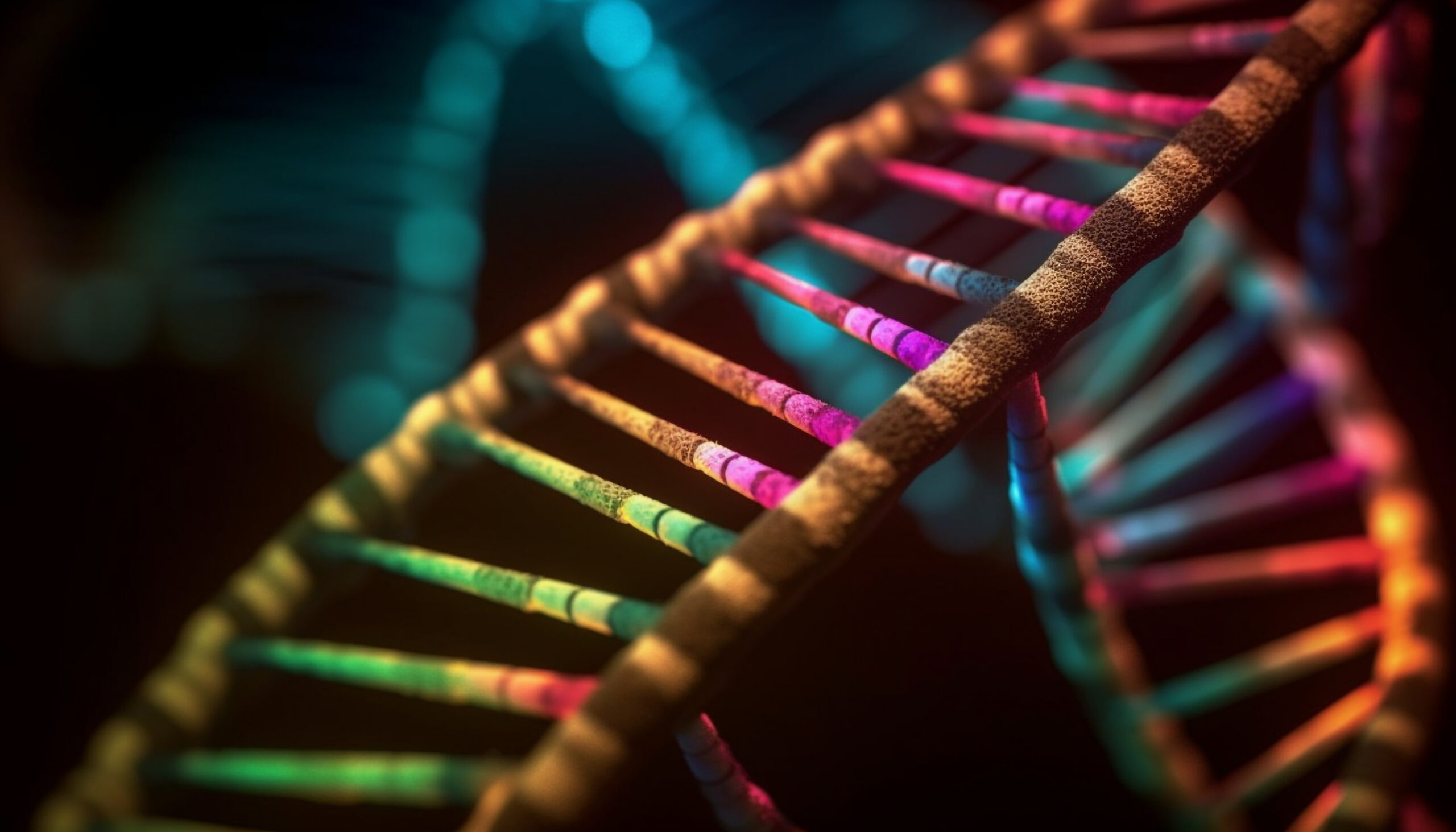GISH
- GISH (genome in situ hybridization) is a cytogenetic technique for radio labeling portions of the genome within cells.
- GISH was created for plant breeding and animal hybrid cell lines.
- The GISH approach, which is an improvement on FISH, is commonly used to examine plants.
- GISH approaches aid in the differentiation of a cell’s genomes.
- Because this strong technique can discriminate genomes in hybrids,
- GISH is now being utilized to research hybrid cell lineages, genetic improvement programs, and polyploid evolution.
- GISH is a tool for analyzing meiotic behavior in hybrids and polyploids, which provides information about species relationships.
The Main steps involved in the genomic in situ hybridization are:
- Direct or indirect labeling of probe.
- Blocking DNA fragmentation
- Preparation of slide.
- Denaturation of Probe and blocking DNA in a hybridization mixture.
- Addition of the probe and the blocking DNA with the hybridization mixture.
- Chromosome DNA denaturation.
- Hybridization of blocking DNA and probe in the target sequence of the chromosome.
- Detection of the probe in the chromosome of one parent.
- Chromosome DNA molecule of the second parent related to the unlabeled blocking DNA.
- Visualization of hybridization signals in a fluorescence microscope. Unlabeled chromosomes are visualized with a counterstain (blue).
The major application of GISH technique are as follows:
- Meiotic studies of chromosome.
- Determination of phylogenetic relationship.
- Determine the positions of translocation breakpoints in chromosome
- Comparative genomic studies of malignant and normal cells of an individual
- Identification of unknown genome
- To identify the hybridized genome of crop varieties
- What does GISH stand for?
a) Gene in situ hybridization
b) Genome in situ hybridization
c) Genetic in situ hybridization
d) Generalized in situ hybridization
Ans: b - GISH is considered an advancement of which technique?
a) PCR
b) RIA
c) FISH
d) ELISA
Ans: c - Which field is GISH most commonly used in?
a) Human medicine
b) Plant breeding and cytogenetics
c) Virology
d) Pharmacology
Ans: b - What type of labeling is used in GISH?
a) Fluorescent only
b) Radioactive only
c) Direct or indirect labeling
d) Enzyme-based labeling
Ans: c - Which of the following is a step in the GISH process?
a) Protein isolation
b) RNA sequencing
c) Blocking DNA fragmentation
d) ELISA plate coating
Ans: c - What is the primary microscope used to observe GISH results?
a) Compound microscope
b) Scanning electron microscope
c) Fluorescence microscope
d) Phase contrast microscope
Ans: c - In GISH, unlabeled chromosomes are visualized using:
a) DAPI counterstain
b) Radioactive dye
c) PCR
d) Coomassie blue
Ans: a - The purpose of blocking DNA in GISH is to:
a) Enhance fluorescence
b) Prevent non-specific hybridization
c) Increase radioactivity
d) Destroy unwanted chromosomes
Ans: b - Which of the following is a major application of GISH?
a) Glucose monitoring
b) Gene therapy
c) Polyploid genome analysis
d) Protein sequencing
Ans: c - Which technique allows for detection of hybrid genomes in crops?
a) PCR
b) GISH
c) Northern blotting
d) SDS-PAGE
Ans: b
- GISH is highly useful in analyzing:
a) Mitochondrial DNA
b) Meiotic chromosome behavior
c) Protein synthesis pathways
d) Antibody production
Ans: b - What is a common blue counterstain used in GISH for unlabeled chromosomes?
a) Rhodamine
b) FITC
c) DAPI
d) Biotin
Ans: c - GISH can identify unknown genomes based on:
a) RNA hybridization
b) Morphology
c) Probe binding patterns
d) Enzyme activity
Ans: c - Which of the following can be detected using GISH?
a) Amino acid sequence
b) Antigen structure
c) Chromosomal translocation breakpoints
d) Protein folding
Ans: c - Which DNA is used as a probe in GISH?
a) RNA probe
b) Complementary DNA probe
c) Genomic DNA from one parent
d) Protein-based probe
Ans: c - What does GISH help distinguish in hybrids?
a) Type of RNA
b) Individual genes
c) Parental genomes
d) Cell membranes
Ans: c - What is denatured during GISH preparation?
a) Protein
b) Chromosomal DNA and probe DNA
c) Lipids
d) RNA
Ans: b - GISH is most commonly used in which group of organisms?
a) Animals
b) Fungi
c) Plants
d) Bacteria
Ans: c - Which of the following is not a GISH application?
a) Phylogenetic relationship analysis
b) Antibody detection
c) Identification of hybrid genomes
d) Cytogenetic analysis
Ans: b - Which one is the best reason for using GISH in polyploidy research?
a) It shows protein concentration
b) It distinguishes individual genomes
c) It blocks mutations
d) It enhances PCR signals
Ans: b
- Which stain is commonly used to counterstain DNA in GISH?
a) Crystal violet
b) DAPI
c) Sudan black
d) Gram stain
Ans: b - The unlabeled blocking DNA used in GISH comes from:
a) The same species as the probe
b) A different genus
c) The second parent genome
d) Fungal cells
Ans: c - GISH is particularly helpful in identifying:
a) Protein modifications
b) Cell wall components
c) Parental genomes in hybrids
d) Enzyme activity levels
Ans: c - Which of the following is not a key step in GISH?
a) RNA transcription
b) Slide preparation
c) Denaturation
d) Hybridization
Ans: a - Which property of chromosomes helps GISH in genome identification?
a) Shape
b) Sequence complementarity
c) Size only
d) Weight
Ans: b - In GISH, genome differentiation is visualized by:
a) Sound waves
b) Electric current
c) Fluorescent signals
d) Ultracentrifugation
Ans: c - Which DNA is denatured during GISH?
a) Mitochondrial DNA
b) Ribosomal DNA
c) Chromosomal DNA and probe DNA
d) Plasmid DNA
Ans: c - Why is blocking DNA used in GISH?
a) To prevent staining
b) To destroy probe
c) To reduce nonspecific binding
d) To enhance brightness
Ans: c - GISH helps to detect translocations by showing:
a) Protein bands
b) Radioactivity
c) Fluorescent hybridization signals
d) Nucleotide changes
Ans: c - The DNA probe in GISH is usually derived from:
a) RNA transcripts
b) Protein sequences
c) One parent genome
d) Enzyme markers
Ans: c
- Which of the following is used to label the DNA probe in GISH?
a) Glucose
b) Fluorochrome
c) Enzyme
d) Antibiotic
Ans: b - GISH technique is primarily applied in:
a) Medical diagnosis
b) Protein purification
c) Plant genome studies
d) Metabolism studies
Ans: c - In hybrid plants, GISH allows detection of:
a) Leaf morphology
b) Genome origin
c) Mineral uptake
d) Cell division rate
Ans: b - Which hybridization technique is used in species identification and evolutionary studies?
a) ELISA
b) PCR
c) GISH
d) HPLC
Ans: c - Fluorescent signals in GISH are visualized using:
a) UV spectrophotometer
b) Light microscope
c) Fluorescent microscope
d) Centrifuge
Ans: c - In GISH, hybridization occurs between:
a) RNA-RNA
b) DNA-RNA
c) DNA-DNA
d) Protein-DNA
Ans: c - Which of these is not a major application of GISH?
a) Genome identification
b) Translocation detection
c) Antibody quantification
d) Phylogenetic study
Ans: c - What is the typical outcome of successful GISH?
a) PCR band
b) Enzyme activity
c) Visible fluorescent hybridization patterns
d) DNA sequence
Ans: c - Which technique helps in the physical mapping of genomes in hybrid species?
a) PCR
b) GISH
c) ELISA
d) Immunoblotting
Ans: b - Why is GISH preferred over traditional staining in hybrid detection?
a) It’s cheaper
b) It uses proteins
c) It shows precise genome origin
d) It requires no microscope
Ans: c
- In polyploid research, GISH is used to determine:
a) Gene duplication only
b) Metabolic rates
c) Parent-specific chromosomes
d) Ribosome activity
Ans: c - A fluorescent dye commonly used in GISH is:
a) FITC
b) Hematoxylin
c) Methylene blue
d) Coomassie blue
Ans: a - Blocking DNA competes with probe DNA for:
a) Non-target sequences
b) RNA sequences
c) Proteins
d) Membrane binding
Ans: a - What is the main goal of hybridization in GISH?
a) Detect proteins
b) Match nucleotide sequences
c) Measure fluorescence
d) Produce enzymes
Ans: b - Genome-specific signals in GISH allow researchers to:
a) Count ribosomes
b) Identify specific parent chromosomes
c) Clone DNA
d) Produce antibodies
Ans: b - In which case is GISH not useful?
a) Studying transgenic animals
b) Differentiating protein types
c) Tracking genome transmission
d) Polyploid evolution
Ans: b - The technique that follows FISH and improves genome specificity is:
a) PCR
b) GISH
c) ELISA
d) RIA
Ans: b - GISH is important for studying:
a) Metabolic enzymes
b) Genome composition in polyploids
c) DNA methylation
d) Histone proteins
Ans: b - Which of the following statements is true about GISH?
a) Only used in humans
b) Requires living cells
c) Uses labeled and blocking DNA
d) Cannot detect chromosomal rearrangements
Ans: c - What is the fluorescent pattern seen in GISH used to determine?
a) DNA polymerase activity
b) Origin and identity of chromosomes
c) Number of centrioles
d) Ribosomal function
Ans: b

